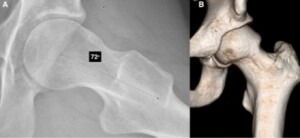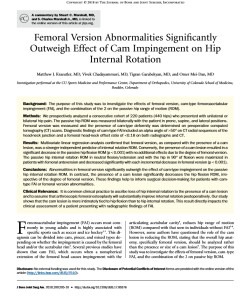Femoroacetabular impingement (FAI) occurs most commonly in young adults and is typically associated with specific sports such as soccer and ice hockey. This diagnosis can be divided into cam, pincer, and mixed types depending on whether the impingement is caused by the femoral head and/or the acetabular rim.
A detailed study was performed was to investigate the effects of femoral version, cam-type femoroacetabular impingement (FAI), and the combination of the 2 on the passive hip range of motion (ROM). The researchers performed a single-center prospective study of a consecutive cohort of 220 patients undergoing hip arthroscopy.
Hip Arthroscopy for Patients with Cam-Type FAI
In this prospective analysis of 440 hips, the most important finding was that abnormalities of femoral version significantly outweigh the effects of a cam lesion on hip internal rotation ROM. However, in hips with femoral anteversion, cam impingement significantly decreased internal rotation ROM.
These results demonstrate the importance of evaluating the overall hip anatomy, including femoral version, in patients presenting with symptoms of impingement.
Cam-type FAI results from a non-spherical extension of the femoral head causing impingement against the spherical acetabular cavity. Patients with a cam lesion often have pain and a reduced hip ROM, specifically internal rotation.
Traditionally, surgical treatment of FAI required surgical hip dislocation. In recent years, arthroscopic treatment of FAI has become the norm, with a number of studies showing successful outcomes in terms of reduced pain levels, improved function, and return to sports.
In addition to successful pain relief and improvements in functional outcomes, hip arthroscopy for patients with cam-type FAI has been shown to result in significant increases in ROM postoperatively.

Figs.1-A through 1-D
FemoralversionmeasurementsusingoverlappingaxialCTimages.
Fig.1-A
Normalfemoralversion
Fig.1-B
Femoralanteversion.
Fig. 1-C Mild femoral retroversion.
Fig. 1-D Extreme femoral retroversion.
Need to Evaluate Overall Hip Anatomy
When a patient presents with symptoms of hip impingement, the surgeon should evaluate the overall anatomy of the hip, as hip impingement is a multi-factorial diagnosis that may occur as a result of a combination of cam-type FAI, abnormal femoral version, acetabular version, and/or acetabular osseous coverage.
When a patient has femoral retroversion, the surgeon may consider offering procedures such as a derotational femoral osteotomy in place of, or in addition to, arthroscopic management of cam lesions. Future studies should be performed to compare the effects of cam resection, derotational femoral osteotomy, and a combination of these procedures on improvements in hip ROM, pain, and functional activities.
Cam Lesion Related to Hip Flexion
Abnormalities of femoral version signifycantly outweigh the effect of cam-type impingement on passive hip internal rotation ROM. In contrast, cam-type impingement significantly decreases hip flexion ROM, irrespective of the degree of femoral version. These findings help to inform surgical decision-making for patients with cam-type FAI or femoral version abnormalities.
Clinical Relevance: It is common clinical practice to ascribe loss of hip internal rotation to the presence of a cam lesion and to assume that arthroscopic femoral osteoplasty will substantially improve internal rotation postoperatively. This study shows that the cam lesion is more intimately tied to hip flexion than to hip internal rotation. This result directly impacts the clinical assessment of a patient presenting with radiographic findings of FAI.

Cam lesion seen on a cross-table lateral radiograph with measurement of the alpha angle (Fig. 2-A) and on a 3D CT scan (Fig. 2-B).
Dr. Tigran Garabekyan is a board certified orthopedic surgeon specializing in hip preservation. To learn more about Southern California Hip Institute or to schedule a consultation, click here to contact us or call:
North Hollywood: 818.755.6500
Century City / Los Angeles: 310.595.1030
Serving patients in Encino, Sherman Oaks, Van Nuys, North Hollywood, Burbank, Glendale, West Hollywood, Century City, Beverly Hills, Santa Monica, Los Angeles, and other neighboring cities in the greater Los Angeles, California area.
Also visit http://www.drgorthopedics.com/






